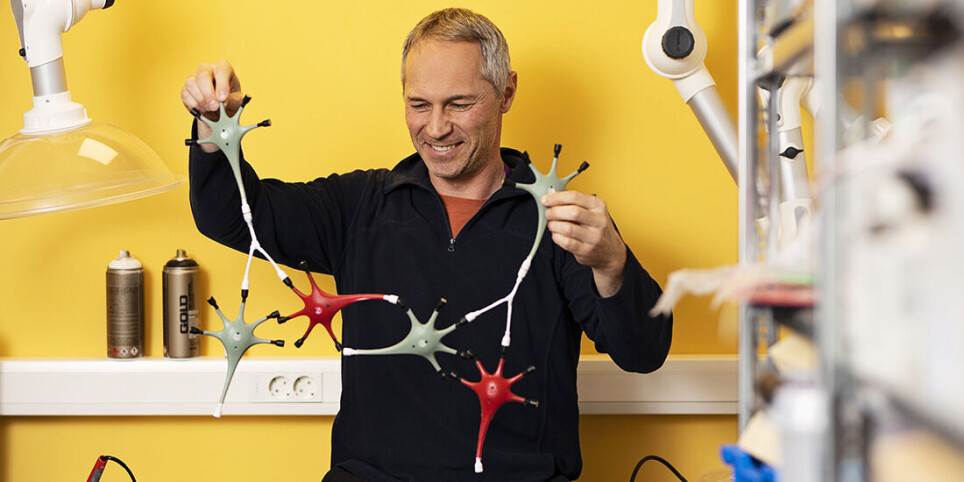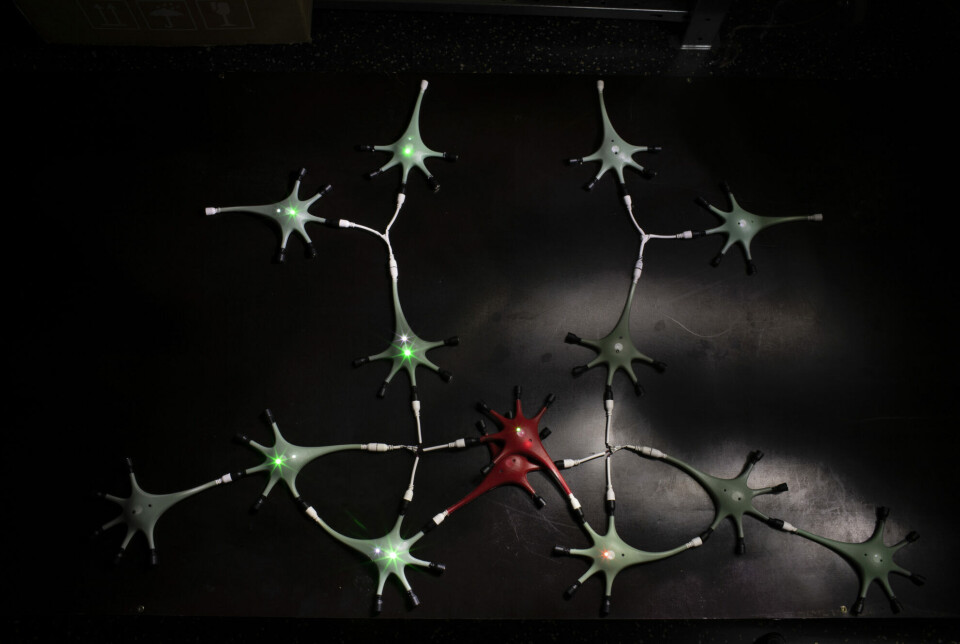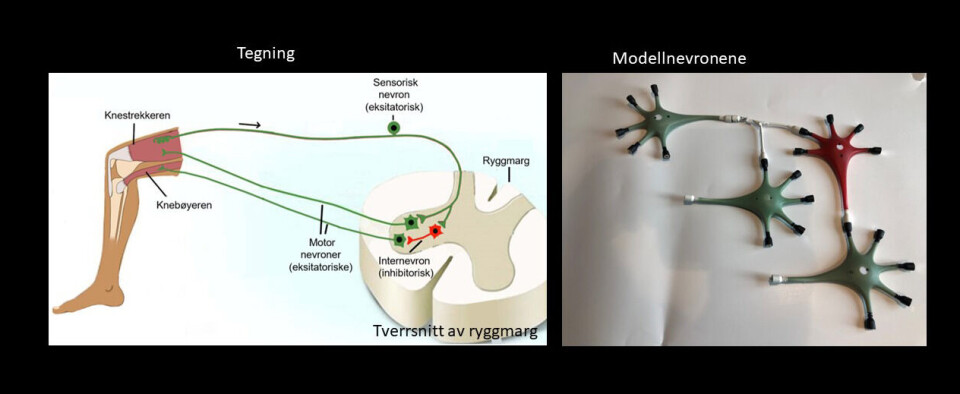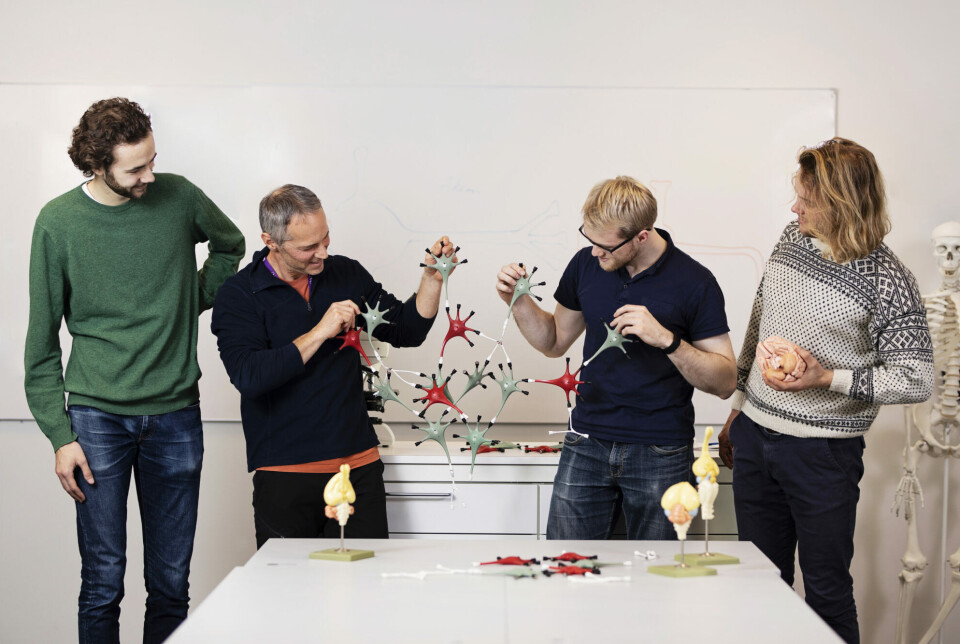THIS ARTICLE/PRESS RELEASE IS PAID FOR AND PRESENTED BY NTNU Norwegian University of Science and Technology - read more

How do our nerve cells work together?
How can we explain to school students how our nervous system works? An NTNU researcher has created a building kit designed to make our brain’s activity easier to understand.
“There’s an enormous amount that we don’t yet know about the brain and nervous system – but we also know a lot that needs to be made accessible to most people,” Pål Kvello says.
He is an associate professor at NTNU’s Department of Teacher Education.
Kvello believes that today’s textbooks fall short in conveying the understanding that students deserve. The idea of creating a building kit of neurons that shows how the nervous system works in a simple way came up while he was working on his doctorate in neurobiology.
Kvello received a good response to the idea in his new teacher education position, and ordered components from China.
With the help of students and Professor Lars Lundheim, the result has been a building kit with simplified rubber neurons that contain internal electronics.
Pål Kvello is now leading a research project that tests how such construction kits can make teaching about the nervous system more understandable.

Building a nervous system
Neurons have branch-like extensions called dendrites that receive signals, and a long projection called an axon that sends signals. The neurons connect to each other to form networks.
A green diode lights up by pressing a button on a model neuron, and a signal is sent out. The students can see how the signal spreads in the network by green and white lights that light up on the neurons. How the signal spreads depends on how the students have built the network.
The aim is to create simplified models that illustrate various functions in the nervous system.
“The signal is activated in some neurons, but stops in others. In some cases, the signal begins to loop. A loop contributes to maintaining or repeating an activity– like walking – whether it is a thought, a feeling or a behaviour. The visible signals enable students to see the logic in the network,” Kvello says.
Each group of pupils receives 10 model neurons to practise with. The green nerve cells activate the signal, while the red ones stop the nerve signal.
More than reflexes
“The classic textbook example is the knee-jerk reflex where the doctor taps the tendon under the kneecap and causes the foot to suddenly kick out. The signal triggered by the sharp tap is sent to the spinal cord which automatically sends back a signal that leads to the reaction,” he says says.
According to Kvello, this example is far too simple.
"The nerve signals, and how they spread in neuron networks, are crucial for everything we sense, experience, feel, think, do, remember and learn. So we have to be able to explain it better,” he says.
The kit that Kvello and his colleagues have produced can demonstracte more than pure reflexes.
“We can, for example, show how the brain determines that a car is coming from the right and not from the left, how we can keep our eyes focused even when we’re moving and how we determine the direction a sound is coming from,” he says.

Better than computer simulation
The building kit could certainly also help to illustrate more complicated cognitive processes, but we still know too little about how to illustrate them in a micronetwork.
Kvello believes the brain building kit improves on a computer simulation.
“Being able to touch, manipulate and connect the parts physically is key. We started with biological neurons from the cerebral cortex of rats, removed a number of unnecessary functions, simplified them and made some educational adaptations,” he says.
The point is to show the principles of how nerve cells perform everyday functions. Usually we learn that we register something with our senses, and that triggers a signal that is then sent to the brain.
Then something or other happens – before a signal comes back from the brain that results in a behaviour. Explained this way, the brain remains a black box, and we have no idea what actually goes on there.
The building kit shows the logic of what occurs. We can follow the nerve signal from neuron to neuron in a model network, just like signals are processed in the brain, says Kvello.
He believes that varying how we teach topics is also a strength, and that the brain building kit can be a useful tool in addition to the others.

Promising signs
Two master’s theses in the teacher education programme have studied how the use of the building kit affects learning outcomes, motivation and dialogue among pupils in upper secondary schools.
“We still have limited data, but we see a clear increase in the pupil dialogue. Groups that use the building kits discuss much more among themselves and are more exploratory than the groups that don’t use them,” Kvello says. “In addition to the master’s theses, 45 student teachers have used the building kits in their teaching. The students also report greater motivation, learning outcomes and understanding, but we do not yet have scientific evidence for this."
Relevant for all levels
The brain building kit is intended for use from primary school to university level.
“We believe it’s important for student teachers to gain the best possible insight into the nervous system so that they are capable of conveying the information to pupils in the natural sciences and health subjects early on,” Kvello says.
He estimates that a group of teachers will need a couple of hours of training to be able to use the building kit effectively.
Sensory neurons
For now, pupils are initiating the signals by pressing a button on the neuron models, but the project will eventually equip the building kits with artificial sensory neurons that perceive light and movement and send signals to the neuron network.
In this way, the building kits will become more realistic.
References:
Heggland et al. Electrophysiological characterization of networks and single cells in the hippocampal region of a transgenic rat model of Alzheimer’s disease, Eneuro, an open-access journal of Society for Neuroscience, 2019. DOI: 10.1523/ENEURO.0448-17.2019
P. Kvello and N. Gericke. Identifying knowledge important to teach about the nervous system in the context of secondary biology and science education–A Delphi study, Plos One, 2021. DOI: 10.1371/journal.pone.0260752
Read more content from NTNU:
-
Are you more jealous of emotional or sexual infidelity?
-
More than 120,000 Norwegians suffer from work-related anxiety
-
Forever chemicals affect ducklings' genes while they are still in the egg
-
Why are pregnant women in Norway so worried?
-
Politics on Facebook: Populist parties choose divisive issues on purpose
-
Social media is connected to cyberbullying – but not how we thought





































